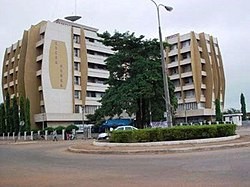Akatekyi Crocodile Pond: A Place...
September 29, 2025
The Techiman Municipal District, located in the Bono East Region of Ghana, is one of eleven districts in the region. Originally established as Techiman District on March 10, 1989, it later underwent changes when the northern portion split off to form Techiman North District on June 28, 2012. The remaining part retained the name Techiman District, which was subsequently elevated to municipal district assembly status and renamed Techiman Municipal District in the same year. This district is positioned in the western area of the Bono East Region and has Techiman as its administrative center.
The Techiman Municipal District is part of the larger framework of 261 Metropolitan, Municipal, and District Assemblies (MMDAs) in Ghana. It constitutes one of the eleven Municipalities and Districts in the Bono East Region, with Techiman as its capital.
Geographically, the Municipality lies in the central part of the Bono East Region, spanning between longitudes 10° 49' east and 20° 30' west, and latitudes 8° 00' north and 7° 35' south. The total land area of the Municipality is approximately 639 square kilometers, resulting in a high population density of 227.7 persons per square kilometer. This population density has significant implications for the socio-economic development of the area.

As of the 2021 Population and Housing Census, the Municipality's population stands at 243,335, comprising 118,699 males and 124,636 females. In the 2010 Population and Housing Census, the population was 147,788, representing 6.4 percent of the region's total population. Urban areas host a larger proportion of the population (64.5%) compared to rural areas (35.5%). The age distribution shows a youthful population, with 13.6% falling within the 0-4 age group and a small percentage (3.0%) being 70 years or older.
Key demographic indicators highlight the Municipality's fertility, mortality, and migration patterns. The total fertility rate is 3.47, with a general fertility rate of 103.3 births per 1000 women aged 15-49 years. The Municipality experiences a crude birth rate of 27.8 per 1000 population and a crude death rate of 6 per 1000. Age-specific death rates differ by gender, with higher death rates among males aged 70 and above and females under 5 years old.
Household characteristics reveal an average household size of 4 persons, with children constituting 43 percent of households. Among the population aged 12 years and older, 43.4 percent are married, 43.8 percent have never married, and smaller proportions are in consensual unions, widowed, divorced, or separated. Education and employment patterns also vary by marital status.
The Municipality's economy is primarily based on agriculture, with the cultivation of food and cash crops playing a crucial role. Techiman's vibrant market serves as a significant commercial center, attracting traders from neighboring West African countries. The service sector, including telecommunications and financial institutions, contributes to economic growth. Additionally, efforts are being made to promote tourism, taking advantage of natural attractions, cultural festivals, and historical sites.
Infrastructure and social services in the Techiman Municipal District include road networks, educational institutions, healthcare facilities, and communication services. The traditional authority, represented by the Techiman Traditional Council, plays a vital role in local governance and cultural preservation. Overall, the district's dynamic demographics, economic activities, and cultural heritage contribute to its social and economic developmen.
The Techiman Municipal District, situated in the Bono East Region of Ghana, encapsulates a storied history of development and transformation. Its geographical positioning, demographic characteristics, economic endeavors, and cultural heritage collectively mold it into a vibrant entity within the broader framework of Ghana's regional and municipal landscape
September 29, 2025
September 29, 2025
September 26, 2025
September 18, 2025
September 18, 2025
September 4, 2025
September 3, 2025
August 28, 2025
August 19, 2025
August 8, 2025